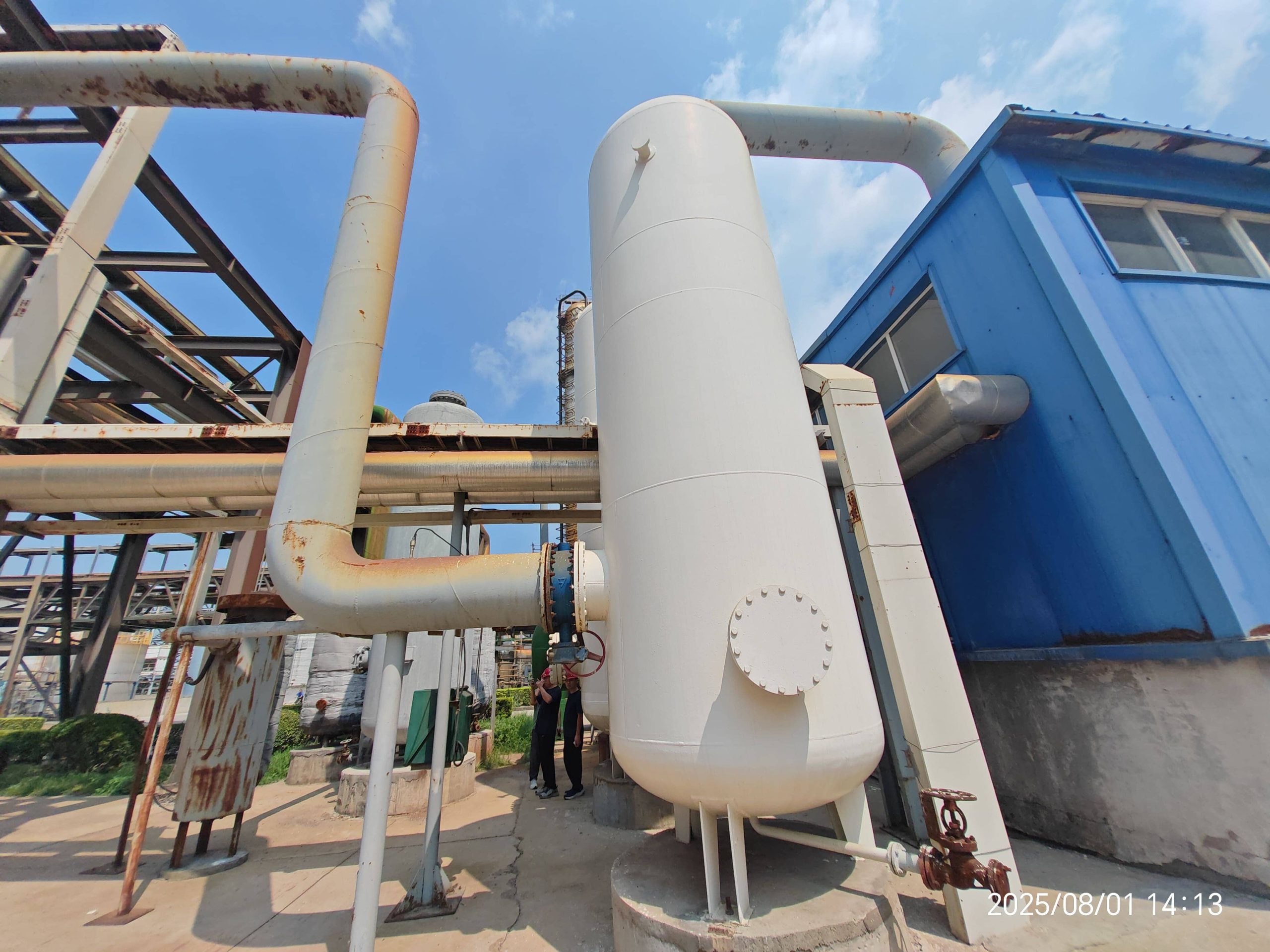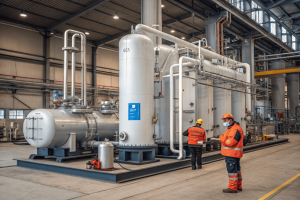How Do You Measure CO₂ Emission Efficiency?
•
How Do You Measure CO₂ Emission Efficiency?
You hear terms like "emission efficiency" and "capture rates," which can be confusing. Misunderstanding these numbers can lead to poor investment decisions or unrealistic expectations for your plant's performance.
CO₂ emission efficiency is a net metric. It measures the final reduction in CO₂ emitted per unit of output (like a megawatt-hour of electricity) after accounting for the extra energy consumed by the capture process itself. It is not just the capture percentage.

I always start discussions about efficiency by drawing two columns on a whiteboard: "Gross" and "Net." A capture plant might remove 90% of the CO₂ from the flue gas (Gross), but if it forces the power plant to burn 20% more fuel to operate, the net reduction in emissions is much lower. It's this final "Net" number that really matters for both your environmental impact and your operational budget. Understanding this difference is the key to evaluating any carbon capture project realistically.
Is 100% carbon capture really possible?
The goal of "net-zero" makes 100% capture sound like the ultimate solution. But chasing this perfect number can be technically difficult and financially crippling, potentially leading to an unfeasible project.
While theoretically possible on a very small lab scale, achieving 100% capture in a large industrial process is not practical or economically viable. The law of diminishing returns means capturing the last few percent of CO₂ requires an exponential increase in energy and equipment size.

I often advise clients to think of it like filtering water. Removing the big particles is easy. Removing 90% of the impurities is standard. But getting to 99.999% pure requires multiple, complex, and very expensive additional steps. It’s the same with flue gas. Capturing the bulk of the CO₂ is a solved engineering problem. Grabbing those last few molecules as they rush up a giant smokestack is a much harder and more expensive challenge.
The Law of Diminishing Returns
The energy and capital cost to capture a ton of CO₂ is not linear. It gets much more expensive as you approach 100% purity. This is because the CO₂ becomes more and more dilute, and the equipment has to work harder to find and grab each remaining molecule.
| Capture Rate | Relative Cost & Energy per Ton | Engineering Reality |
|---|---|---|
| 0 - 90% | Baseline (1x) | This is the design "sweet spot" for most technologies. |
| 90 - 95% | Moderately Higher (1.5x - 2x) | Requires larger equipment and more energy. |
| 95 - 99% | Exponentially Higher (5x+) | Becomes economically and physically impractical. |
Because of these steep increases, almost all large-scale projects are designed for a capture rate of around 90-95%. This provides the best balance between high environmental performance and manageable project economics.
What is the real problem with carbon capture?
Carbon capture is presented as a key climate solution. But the high costs, energy penalties, and logistical challenges make widespread adoption very difficult for many companies to justify on their own.
The main problems with carbon capture are the high capital and operational costs, the significant energy penalty that reduces the host plant's net output, and the logistical challenge of transporting and permanently storing the massive volumes of captured CO₂.

When I'm engineering a solution, I have to be realistic about the trade-offs. We can absolutely capture CO₂. The technology works. But it creates a new set of challenges. It's an industrial process that costs a lot of money to build and run. It consumes a significant amount of energy, which has its own cost. And once you've captured the CO₂, you are responsible for it. You have to get it somewhere and make sure it stays there. Each of these is a major project in itself.
The Three Core Hurdles
The challenges can be broken down into three main categories. Each must be solved for a project to be successful.
| Problem Category | Specific Challenge | Impact on Project |
|---|---|---|
| Economic | High CAPEX for the plant and high OPEX for energy and maintenance. | Requires hundreds of millions in initial investment. |
| Engineering | The "energy penalty" can consume 15-25% of the plant's output. | It directly reduces revenue by lowering saleable product. |
| Logistics | Requires a pipeline or fleet of trucks plus a certified underground storage site. | Creates long-term infrastructure and liability needs. |
This is a key reason why CO₂ Utilization (CCU), where the CO₂ is used as a product, is so attractive. It helps solve the logistical and economic problems by creating a revenue stream to offset the cost of capture, avoiding the issue of long-term storage entirely.
How much does it really cost to capture 1 ton of CO2?
You need to budget for a new carbon capture project. But the "cost per ton" figure you find online can vary wildly, making it very difficult to create a reliable financial model.
The cost to capture one ton of CO₂ ranges from $25-$50 for high-purity sources like industrial fermentation to $60-$150+ for more dilute streams like flue gas from power plants. The exact cost depends heavily on CO₂ concentration and project scale.

When a client asks me for a price, my first question is always, "What is your source gas?" The answer changes everything. Capturing CO₂ from a brewery's fermentation tank, where the gas is over 99% pure, is a relatively simple act of purification and liquefaction. The equipment is smaller and uses less energy. Trying to capture CO₂ from a natural gas boiler, where it's only 10% of the exhaust stream, requires a massive chemical separation plant first. The cost difference is enormous.
Key Factors Influencing Cost
The final cost per ton is not a single number but is determined by a few key variables of your specific project.
- CO₂ Concentration: This is the single biggest factor. The more concentrated the CO₂, the less work needs to be done to separate it, and the lower the cost. High-purity sources are always the cheapest.
- Scale of the Project: Larger facilities benefit from economies of scale. A plant capturing millions of tons per year will have a lower cost per ton than a small industrial unit capturing a few thousand tons.
- Energy Costs: The capture process is energy-intensive. The local price of electricity and steam will directly impact the operational cost (OPEX).
- Transportation & Storage: If you are not utilizing the CO₂ on-site, you must factor in the cost of pipelines or trucking and the fees for permanent geological sequestration.
Understanding these variables is the first step to developing a realistic budget for your project.
Conclusion
CO₂ emission efficiency is a net figure, accounting for the energy penalty of capture. While 100% capture is impractical, high costs and storage logistics remain the biggest challenges for the industry.
You may also be interested in:

Why is CO₂ recovery technology gaining popularity worldwide?
Why is CO₂ recovery technology gaining popularity worldwide? You see headlines about carbon capture everywhere. But you wonder if it's
Read more
How is a CO₂ recovery system designed to fit different industries?
How is a CO₂ recovery system designed to fit different industries? You're under pressure to implement a CO₂ recovery solution.
Read more
How energy-efficient are today’s CO₂ recovery technologies?
How energy-efficient are today’s CO₂ recovery technologies? You want to recover CO₂, but you fear that high electricity bills will
Read more